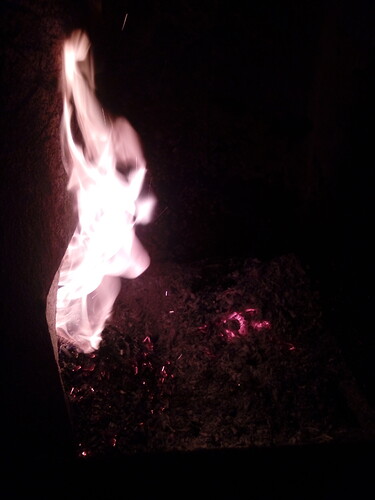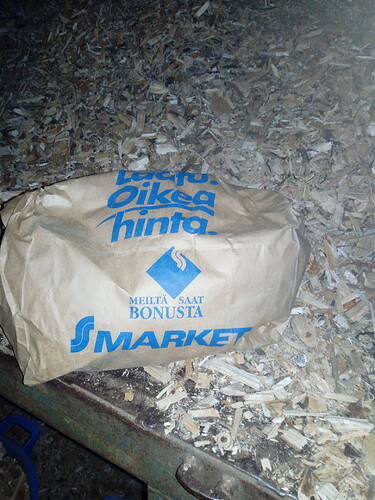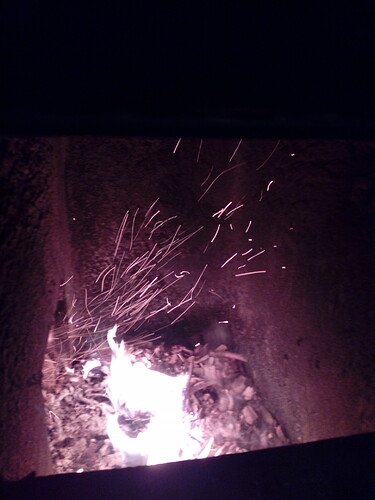The main thing is to get started and make some gas Dillon. I was told the same thing when I joined and instead of starting out with a basic simple fire I made something that took much longer and had way more of a learning curve to make it work. You don’t even need to power an engine on your first build, if you don’t have one. Just make gas and flare it. It will give you confidence that you can actually do something and then expand on it.
Tom Holton, that sounds like a great plan I think I’ll do that
sorry about the wood, i live i me forrest, but neighbour make the woodchips.
you can also use Fuel wood pellets.
i warm me house for long time , using wood-chips
and observing the process , burning flame …
study here in chat and book Vesa Mikkonen.
in spring i go visiting , the 3 wood gas installation in a farm
yesterday i was visiting a metal scrap place
there are 5 old woodburner, and i thing bring 1 at home, for me projeckt.
learning englisch writing
that me position
Good Morning Dillon. Welcome to the DOW.
Does your lumber yard give, and forests give you softwoods/conifer wood; or deciduous hardwoods? Like maple and oak.
Regards
Steve Unruh
Haapio, nice chips you are getting. No leaf. No needles. Bark content consistant with limb and twig chipping.
You show a burning picture below.
IF this is in an airtight closeable fire box here is a technique.
Put 2 kg into brown paper sacks rolled up tightly.
Place these one at a time onto an existing hot bed of wood charcoal. The paper sack will keep your fuel-lump intact until a blackened outer crust is formed. Then the heat will outgas your fuel wads pyrolosis oils and gases out through this outer burning hot crust. Do not poke or disturb this slow release process or you will break your char skin getting smoking. without the reduction complete combustion.
Close couple woodgasification and full no-smoke combustion of fine wood chips and sawdust.
Done right in a large enough scale you can use up to 40% moisture wood chips/sawdust.
I learned this from WWII Japanese vehicle gasification pictures.
Also I believe how the Danes used dried seaweed for vehicle gasification in their desperate WWII Occupation years.
Regards
Steve Unruh
I’m willing to bet there were a thousand people who came to this site and thought they were going to be running the highways at 80 mph like the pro’s here and gave up when they hit the first hiccup. Any time you burn wood you end up with charcoal. There are some ways to make a lot at a time but to start out you don’t need to do that. Right now I’m just taking it out of my wood stove. Crush it down in a bucket with the head of a hammer or anything and screen it . You are going to want it between a half inch and a quarter inch. you may have to run it through two screens those sizes to get the right fuel size and get rid of the fines and dust but no big deal there. Look at the one Vinrod just built to power his small motorcycle. You won’t need as elaborate hold down at that but in not much time he was running that engine. many examples here. Nozzles are always a problem. They will melt down if not protected with TIG cups or these which Dave from Australia recommended. https://www.ebay.com/c/1832907530
Pipe nipples are pretty cheap. Even if you melt a few starting out no big deal. You can believe that everyone on the site wants you to succeed. This is fun, messing with this stuff. You need some wins when you start out so that you don’t get discouraged. That’s why it’s best to start simple.
Hi Bruce when you are making the energy density comparisons are you factoring in a water drip system. Because this comparison is not my experience at all. Charcoal by weight is roughly 15% to 25% more BTU by weight. Wood chips range from 5500 btu up to 8600 and charcoal is generally 9600 btu pr lb. “google searched for those numbers”
Volume I can see where this can very greatly by how small or large you process your charcoal. On my M-1 Ute gasifier I have achieved 1 1/'2 hour run times running the Predator 420 cc engine power generator. I have years experience running this generator and on woodgas and the 2013 thru 2017 M-4 / Utility direct wood gasifier would also get around a 1 1/2 hour run time. However those gasifiers have larger hoppers. So for me energy density with a good water drip puts them nearly the same as far as energy pr volume goes.
Size pr size 1 inch cube of charcoal verses a 1 inch cube of wood is probably a 2:1 ratio. However, realistic sizing of the fuels for the required gasifier process changes that ratio. The direct chip fuel gasifiers required 1X1X1/2 inch thick chips. The charcoal units you can size to 1/2 inch cubes. So you can fit a lot more charcoal into the same vessel for comparable energy density.
Edit: after sitting here trying to wrap my brain around all this. What you and I are both describing are the same. Factor the water drip into the energy density pr wieght and that gets you to the 50% higher energy density range on average. So factor that higher energy density pr weight = 50% less needed by volume to achieve the same result of raw wood fuel. Ok time to get some Tylenol and get back to work. lol
Its all a matter of your perspective. So what if you ran your chipper with a gasifier? How much fuel do you think it will take for it to fuel itself? In this scenarios you are burning wood to make fuel. When you make charcoal, you are burning wood to make fuel.
Burning wood to run a chipper is way more complex then burning wood in a kiln.
If you use 30 lbs of fuel to produce 80 lbs of fuel do you really get that 80lbs of fuel? Nope, you need to set aside 30 lbs of it for the next time you process fuel. That ratio is pretty realistic after you discard your waste.
Chipping is not straight forward, you generally have process time into prepping the fuel for the chipper. Same goes for charcoal, you have pre process to prepare it for the kiln.
When you are charcoaling think of that heat energy to process to charcoal the same as the fuel it takes to run any processing equipment. When you process for a kiln you generally will process the fuel in much larger chunks and you are really unlimited to what you can process. For instance ever try to chip up a use pallet? It wont fit and it will have nails in the wood. If you cant process waste materials like this than it is really is a waste.
To process for a kiln you do not need big equipment. An electric chain saw, skill saw, chop saw, table saw, and a small splitter is all that is needed. All of this can be ran off of electric from the very power generator you are operating. Even the splitter and all are low power consumption devices. Incorporate your kiln process into a heating application and you have a viable CHP system that produces fuel for itself.
Add in the reliability factor; charcoal systems run very stable and with out tar production. With a direct gasifier you are guaranteed to make tar I promise you this! Its only a matter of when you do. A direct raw fuel stationary gasifier must be automated, there is absolutely no way to overcome grate clogging, hopper bridging, and gas energy density fluctuations 100% with varying fuel inputs without it.
Oh then everyone seems to forget about the water drip system. This is putting energy back for basically free and is a very simple feature to add. With this system, this can boost gas energy density beyond wood gas. We really need to break that myth that wood gas is more powerful than char gas. This is not true at all, a good charcoal unit with a high volume water drip will outperform direct wood gas any day.
Rather than focus on a complex wood gasifier, focus on better charcoal production methods. I have achieved a 50% fuel production ratio with my kiln process and we do use our system for heat. There is no better way IMHO
Cheers
Steve Unruch,
unfortunately I live in an area where we primarily have soft woods. In the forest around here we have spruce, fir, cedar, hemlock, and alder. At my lumber yard we have a slim Selection of hardwood but there is next to no waist off of them. we sell and cut a lot of ceda and fir though.
Tom holton,
I would like to someday have a truck that fast and impressive like Dutch John’s 73 square body Chevy but that project is years off for now I intended to try and learn the basics .
Matt Ryder,
You are right I didn’t think of the additional processing I would have to do to the feed stock with either method. I also like the idea of not producing tars .
Well . . . then you will have limited ability to make all-of-this wonder-fuel charcoal.
The charcoals made with with cedar, fir and hemlock are super fragile. Crumbles to dust with handling.
The commercial folks use these to make that char-dust then with binders make commercial charcoal briquets. More process steps. And those gasify completely different from natural porous wood charcoal.
Want to go charcoal; focus on the red alder.
These Charcoal’tiers guys are all in hardwoods areas! Their knowledge is valid for them. Their areas.
I’ve only ever been able to some charcoal hard enough to be storable, handleably, out fir, hemlock, spruce knotwoods sections. Large machine torn out roots branch sections. 100 year growth very tight grain limb wood.
Made a lot of char dust with clear grain conifer wood sections. And I do not bio-char intentionally.
All raw wood gasifer intentionally do make tars in their upper system. Then those tars converted in mid-system, lower mid-system with the in-place made charcoal/Heats/and controlled flows-turbulence into motor grade fuel gasses.
Tars passed thru to the engine WILL ALWAYS be an Operator, operational problem.
DIY for your own use, become that better Operator.
This is the DOW creed.
Do not be put off by wood fuel prepping. Look up the many on-DOW pictured DIY chunks makers.
You mentioned Dutch John. He did not charcoal. Not in his wood fired cooking stove. Not in his self-made all SS downdraft heating stove. Not in any of his FOUR engine powering projects. 1 1/2 horsepower to ~100 horsepower.
Want easy? Buy propane.
Want a step into solid wood fuels? Buy pellets.
Want challenging? Do raw wood gas.
Read carefully KristijanL’s proposed Double Flute Downdraft gasifer topic. Watch Don Mannes build up powering results.
Not based on speculation. Based on their, done-both, loaded using experiences.
And both doing this on overhead cam engines to boot.
Regards
Steve Unruh
Now Dillon there is good news having primarily soft confer woods.
It is excellent, excellent for woodgasifing.
Has a fast energy release in comparisons to hardwoods.
And those your listed except for the red alder are all under 1% ash to 1 1/2% mineral ash.
Grating for ash separation is easy with soft confer woods.
The hardwood guys are all min 5% to as high as 11% ash. They clog badly lower down with ash and then must grate spill-slip much char to keep the ash from clogging. Or gas velocity blow it through.
Mistake to harwood grate active most conifer woods char-ash. Crumbles it. Then char fines clogging.
And be a mistake to towed system build for primarily conifer wood fuels. Trailers bounce too much. Keep the vehicle system; in-bed; in-trunk, or front or rear hung “gentle”.
And these are not book experiences. Done-it experiences.
For tar-making gooey confer woods keep your hopper small for best rising heat tars softening. Or you will be goo’s chunks hanging up. Bridging. This has been a wide spread experience. Then on to hopper shakers and such.
Big, big mistake to make big hoppers for soft confer woods.
Ha! And soft conifer woods can be chunked 50% larger than hardwood chunks. Less work! ('Cepting you will use 50% more of them)
S.U.
Steve unruh,
Thank you. You really provide some valuable insight in to the best use for the material I have at hand and I believe you saved me a lot of headache. I think my mane focus now will be on wood gas.
Now I have another question to anyone who might have an answer for me. Are there any ratios, equations, or rules of thumb for designing/build a wood gasifire?
Has not been mentioned whether you weld or not. Going to be very difficult to build a raw wood gasifier without welded components. Easy enough with Charcoal. As for hardwood. you probably have access to a lot of pallets and the pieces of cribbing supporting the banded bunks of lumber are often junk hardwood.
I can weld wen it’s needed. I don’t have a welder myself but I can barrow one from work or from my buddy
All the cribbing where I’m at is soft wood and most of the pallets are soft wood also.
I have a 302 I would like to swap in to my ranger in the next year or two and I was thinking building a gasifier for that would be a good project to tackle. Do you think it would be possible to make a bumper mounted unit?
Hi Dillon.
Ha! Back from snow shoveling and kids snowman making.
Basic hearth dimensions can be found in the Library section here.
That is the problem though. Just hearth dimensions without the other 2/3rds Downstream you’ll need to raw wood gasifiy for a vehicle. Coarse soot-ash separation. Cooling and downstream condensate capturing. Engine fuel gas Filtering.
The charcoal systems the gasmaker is 1/2 of the system. Then only some filtering.
Using the magnifing glass tool above search and read sytems for Ford Rangers. 3-4 builders for those. Search up Toyota Pickup systmes too. as similar.
And J.O. Olsen has a woodgas system in a Mitsubishi 4x4 pick up with lots of build pictures and performance results. Similar too.
For your pickup stay in-bed. Then you can build cheapn’heavy. Using air and propane steel tanks. Thick is easiest to weld.
Bumper mounts need to be super light so not really beginner systems.
My next will be an all SS thin metal bumper mounted for my Toyota Camry.
Expensive for the special SS metals. Expensive to weld SS needing special filler wire and shielding gasses.
I searched because I had pictures of a local Ranger w/a small block Chevy. And a different local local guy who has gone 302 carbureted.
BOTH tight, tight squeezes. This will give you difficulty routing up with the large diameter woodgas tubing.
Regards
Steve Unruh
Thank you I’ll check for the plans



